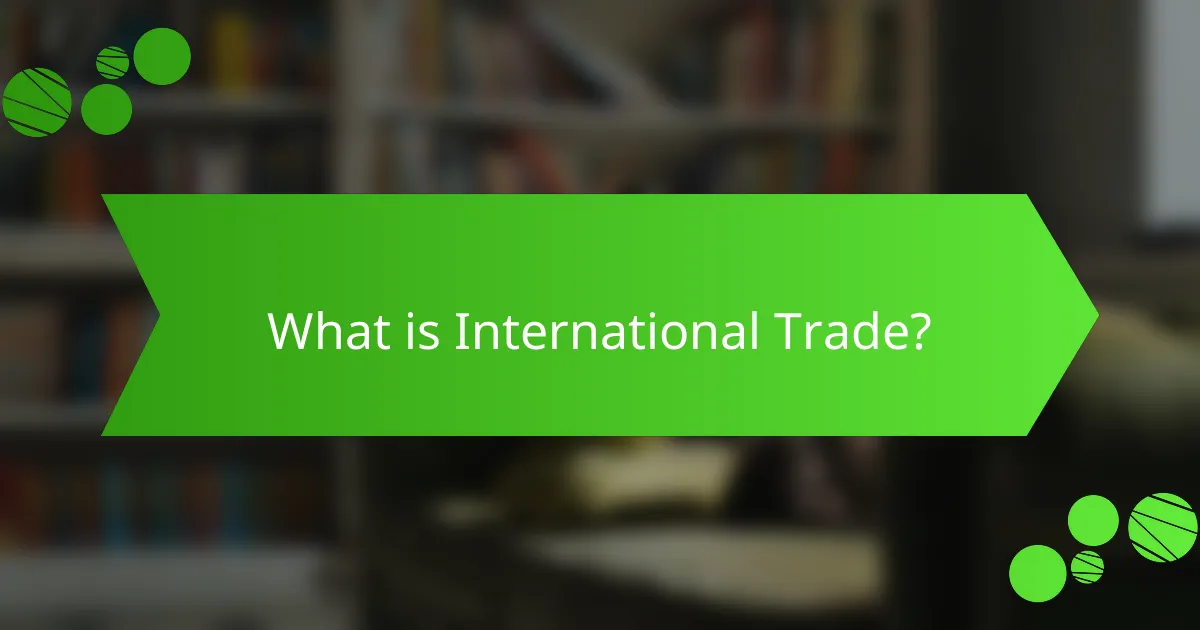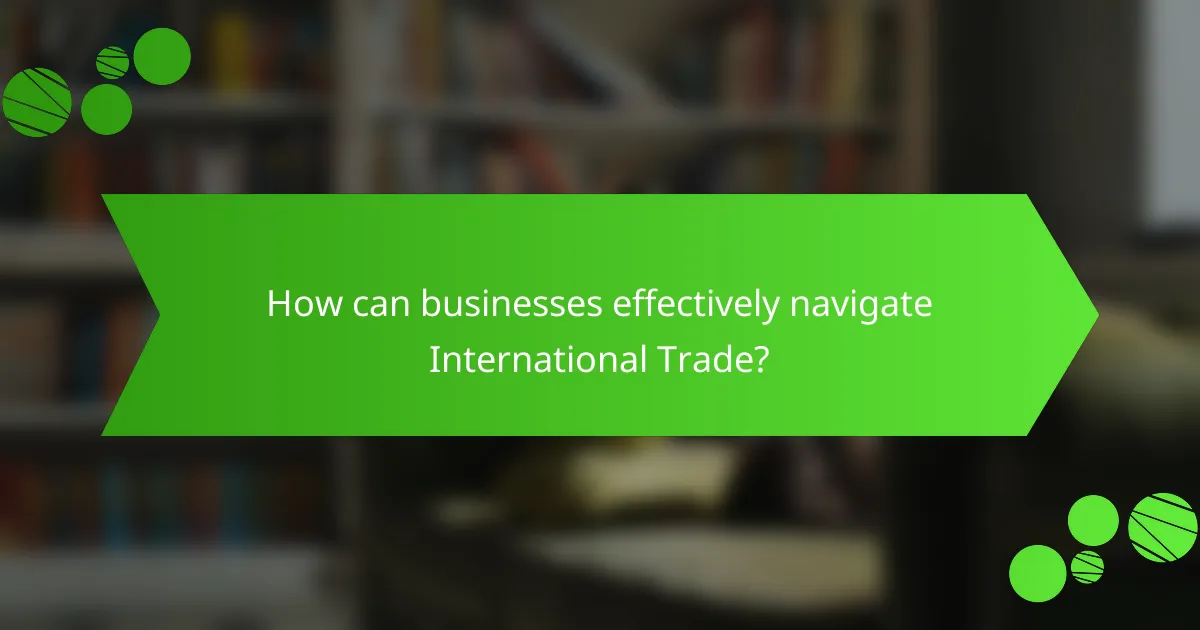International trade refers to the exchange of goods and services between countries, enabling access to products that may not be available domestically. This process fosters economic growth, competition, and innovation, with global trade reaching $22 trillion in 2021. Key economic theories underpinning international trade include absolute advantage, comparative advantage, and the Heckscher-Ohlin theory, which explain how countries can benefit from trade through specialization and efficient resource allocation. Businesses looking to engage in international trade must understand regulations, market dynamics, and cultural differences while leveraging technology for market analysis and establishing strong logistics and partnerships.

What is International Trade?
International trade is the exchange of goods and services between countries. This process allows nations to access products not available domestically. It promotes economic growth by providing markets for exports. Additionally, it encourages competition and innovation. According to the World Trade Organization, global trade reached $22 trillion in 2021. This figure highlights the significance of international trade in the global economy. Countries engage in trade to benefit from comparative advantages. These advantages lead to more efficient resource allocation and specialization.
How does International Trade function in the global economy?
International trade functions as the exchange of goods and services across international borders. It enables countries to access products not available domestically. Trade allows nations to specialize in the production of goods where they have a comparative advantage. This specialization leads to increased efficiency and lower prices for consumers.
The global economy benefits from international trade through enhanced economic growth. According to the World Trade Organization, global trade has grown significantly, contributing to GDP growth in many countries. International trade promotes competition, leading to innovation and improved product quality. Additionally, it fosters international cooperation and strengthens diplomatic ties between nations.
What are the key components of International Trade?
The key components of international trade include goods and services, trade agreements, tariffs, and exchange rates. Goods and services are the primary products exchanged between countries. Trade agreements are treaties that facilitate trade by reducing barriers. Tariffs are taxes imposed on imported goods, affecting pricing and competition. Exchange rates determine the value of one currency against another, influencing trade costs. Each component plays a crucial role in shaping international economic relationships.
How do countries engage in International Trade?
Countries engage in international trade by exchanging goods and services across borders. They do this through various trade agreements, tariffs, and regulations. Trade agreements, such as free trade agreements, reduce barriers to trade. Tariffs are taxes imposed on imported goods, affecting pricing and demand. Countries may also establish trade quotas to limit the amount of a product that can be imported. The World Trade Organization (WTO) facilitates international trade by providing a framework for negotiations and dispute resolution. Global supply chains allow countries to specialize in the production of certain goods. For example, countries may export raw materials and import finished products. Ultimately, international trade is driven by the principles of comparative advantage and market demand.
What are the primary benefits of International Trade?
International trade offers several primary benefits. It enhances economic growth by allowing countries to access larger markets. This access leads to increased production efficiency. Countries can specialize in producing goods where they have a comparative advantage. This specialization improves resource allocation globally. Additionally, international trade fosters competition, which can lower prices for consumers. It also encourages innovation as companies seek to maintain a competitive edge. According to the World Bank, trade can lift millions out of poverty by creating jobs and increasing income levels. Overall, these benefits contribute significantly to global economic development.
How does International Trade enhance economic growth?
International trade enhances economic growth by increasing market access for goods and services. It allows countries to specialize in the production of goods where they have a comparative advantage. This specialization leads to more efficient resource allocation and higher productivity levels. Increased competition from international markets drives innovation and efficiency among domestic producers. According to the World Bank, countries that engage in international trade tend to experience faster economic growth. For instance, trade liberalization in developing countries has led to significant GDP growth rates, often exceeding 5% annually. Furthermore, international trade creates jobs and raises income levels, contributing to overall economic development.
What role does International Trade play in consumer choice?
International trade significantly influences consumer choice by expanding the variety of goods and services available. It allows consumers access to products from different countries, enhancing competition. This competition often leads to lower prices and improved quality of goods. For instance, consumers can choose between domestic and imported products, which may differ in price and features. Additionally, international trade enables the availability of unique products not produced locally. According to the World Trade Organization, trade can increase consumer welfare by providing more options. Thus, international trade plays a crucial role in shaping consumer preferences and purchasing decisions.
What barriers exist in International Trade?
Barriers in international trade include tariffs, quotas, and non-tariff barriers. Tariffs are taxes imposed on imported goods, making them more expensive. Quotas limit the quantity of a specific good that can be imported. Non-tariff barriers include regulations and standards that make it difficult for foreign products to enter a market. These barriers can protect domestic industries but may also lead to trade disputes. According to the World Trade Organization, tariffs can significantly impact trade volumes and economic growth.
How do tariffs and quotas impact International Trade?
Tariffs and quotas significantly impact international trade by restricting the flow of goods between countries. Tariffs are taxes imposed on imported goods, increasing their prices. This makes domestic products more competitive, potentially leading to reduced imports. Quotas, on the other hand, limit the quantity of a specific good that can be imported. This can create scarcity, driving up prices for consumers.
Both tariffs and quotas can lead to trade disputes and retaliation from affected countries. For instance, the U.S.-China trade war saw increased tariffs, affecting billions in trade. According to the World Trade Organization, tariffs can reduce trade volumes by 10-20%. Quotas can also disrupt supply chains, affecting both producers and consumers.
Overall, tariffs and quotas can protect domestic industries but may lead to higher prices and limited choices for consumers.
What are the non-tariff barriers to International Trade?
Non-tariff barriers to international trade are trade restrictions that do not involve tariffs. These barriers include quotas, import licenses, and standards for products. Quotas limit the quantity of a product that can be imported. Import licenses require permission before goods can enter a country. Standards can include health and safety regulations that products must meet. Non-tariff barriers can create significant obstacles for exporters. They may increase costs and complicate compliance for businesses. According to the World Trade Organization, these barriers can distort trade flows and affect market access.

What economic theories underpin International Trade?
The main economic theories that underpin international trade are absolute advantage, comparative advantage, and the Heckscher-Ohlin theory. Absolute advantage, introduced by Adam Smith, states that a country should produce goods it can make more efficiently than others. Comparative advantage, developed by David Ricardo, suggests that countries should specialize in producing goods where they have a lower opportunity cost. The Heckscher-Ohlin theory posits that a country’s factor endowments, such as labor and capital, determine its trade patterns. These theories explain the rationale behind trade and how countries benefit from it. Historical data supports these theories, showing that nations engaging in trade experience increased economic growth and efficiency.
How do classical theories explain International Trade?
Classical theories explain international trade through the concepts of absolute and comparative advantage. Adam Smith’s theory of absolute advantage states that a country should produce goods it can make more efficiently than others. This leads to increased overall production and trade benefits. David Ricardo’s theory of comparative advantage expands this idea. It suggests that countries should specialize in producing goods where they have the lowest opportunity cost.
This specialization allows for more efficient resource allocation globally. Classical theories highlight that trade can benefit all parties involved, even if one country is less efficient in producing all goods. Historical evidence supports these theories, such as the trade patterns seen during the Industrial Revolution. Countries that embraced these principles experienced significant economic growth and improved living standards.
What is the theory of comparative advantage?
The theory of comparative advantage states that countries should specialize in producing goods they can produce at a lower opportunity cost. This means that even if one country is less efficient in producing all goods, it can still benefit from trade. By focusing on their strengths, countries can trade for goods that are more costly for them to produce. This leads to an overall increase in economic efficiency and wealth. The theory was first introduced by economist David Ricardo in the early 19th century. His model demonstrated how trade can be beneficial for all parties involved, even when one party has an absolute advantage in production.
How does the Heckscher-Ohlin model relate to International Trade?
The Heckscher-Ohlin model explains how countries engage in international trade based on their factor endowments. It posits that countries will export goods that utilize their abundant factors of production. For example, a country rich in capital will export capital-intensive goods. Conversely, it will import labor-intensive goods from countries with abundant labor. This model highlights the role of resource distribution in shaping trade patterns. Empirical studies, such as those by Leontief in 1953, demonstrated the validity of this theory. He found that the U.S. exported labor-intensive goods despite being capital abundant, challenging the model’s predictions. Nonetheless, the Heckscher-Ohlin model remains a foundational theory in international trade. It illustrates how comparative advantage is determined by factor endowments rather than technology alone.
What modern theories are relevant to International Trade?
Modern theories relevant to international trade include the New Trade Theory, the Heckscher-Ohlin Model, and the Gravity Model of Trade. New Trade Theory emphasizes increasing returns to scale and network effects. It suggests that countries can benefit from specializing in certain industries. The Heckscher-Ohlin Model focuses on factor endowments, stating that countries export goods that utilize their abundant resources. This model highlights the role of labor, land, and capital in trade patterns. The Gravity Model of Trade predicts bilateral trade flows based on the economic size and distance between countries. It indicates that larger economies trade more with each other, and proximity increases trade volume. These theories provide a framework for understanding the complexities of global trade dynamics.
How does the New Trade Theory differ from classical theories?
New Trade Theory differs from classical theories by emphasizing economies of scale and network effects. Classical theories focus on comparative advantage based on resource endowments. New Trade Theory highlights that large-scale production can lower costs and create a competitive edge. It also accounts for imperfect competition and increasing returns to scale. Classical theories assume perfect competition and constant returns. New Trade Theory illustrates how market size affects trade patterns. For example, countries may specialize in certain industries to achieve cost efficiencies. This approach explains trade flows that classical theories cannot, particularly in high-tech and differentiated goods markets.
What is the role of economies of scale in International Trade?
Economies of scale play a crucial role in international trade by reducing the average cost of production as output increases. This cost reduction allows firms to offer lower prices in global markets. Consequently, businesses can enhance their competitiveness internationally. Larger production volumes enable firms to spread fixed costs over more units. This leads to increased efficiency and profitability. Research indicates that firms achieving economies of scale can capture larger market shares. For instance, a study by the World Bank shows that countries with significant economies of scale often enjoy higher export rates. Thus, economies of scale are essential for driving international trade growth and improving economic performance.

How can businesses effectively navigate International Trade?
Businesses can effectively navigate international trade by understanding regulations, market dynamics, and cultural differences. They should research trade agreements and tariffs that impact their operations. Compliance with international laws is crucial to avoid legal issues. Businesses must also adapt their marketing strategies to local cultures. Establishing strong logistics and supply chain management enhances efficiency. Networking with local partners can provide valuable insights into the market. Utilizing technology for market analysis can inform decision-making. According to the World Trade Organization, understanding trade policies can increase a business’s competitiveness in global markets.
What strategies can companies adopt for successful International Trade?
Companies can adopt several strategies for successful international trade. First, they should conduct thorough market research. Understanding local demand, consumer preferences, and cultural nuances is critical. Next, forming strategic partnerships with local businesses can facilitate market entry. Collaborating with established entities helps navigate regulatory landscapes.
Additionally, companies should focus on compliance with international trade regulations. Adhering to laws and tariffs prevents costly legal issues. Developing a robust supply chain management system is also essential. Efficient logistics ensure timely delivery and cost-effectiveness.
Lastly, investing in technology can enhance communication and operational efficiency. Digital tools streamline processes and improve transparency. These strategies collectively increase the likelihood of success in international markets.
How can businesses mitigate risks associated with International Trade?
Businesses can mitigate risks associated with international trade by diversifying their markets and supply chains. This strategy reduces dependency on a single market or supplier, minimizing the impact of disruptions. Companies should also conduct thorough market research to understand local regulations and economic conditions. Understanding these factors helps in making informed decisions. Additionally, implementing robust risk management frameworks is essential. These frameworks can include insurance against political and economic instability. Regularly reviewing and updating contracts with international partners can also safeguard against unforeseen changes. Lastly, investing in technology to track and analyze trade data enhances decision-making and responsiveness.
What best practices should companies follow in International Trade?
Companies should follow several best practices in international trade. First, they must understand local laws and regulations in each market. Compliance with trade regulations is crucial to avoid legal issues. Next, companies should conduct thorough market research. This helps identify demand and competition in foreign markets. Establishing strong relationships with local partners also enhances market entry. Networking can provide valuable insights and facilitate smoother operations. Additionally, companies should develop a robust supply chain strategy. A well-managed supply chain minimizes delays and reduces costs. Risk management is another essential practice. Companies should assess and mitigate risks associated with currency fluctuations and political instability. Finally, effective communication is vital. Clear communication helps in negotiating and maintaining relationships across cultures. These practices collectively contribute to successful international trade operations.
The main entity of this article is international trade, which encompasses the exchange of goods and services between countries. The article provides a comprehensive overview of international trade, detailing its function in the global economy, key components, and primary benefits such as economic growth and enhanced consumer choice. It also examines barriers to trade, including tariffs and non-tariff barriers, and explores foundational economic theories that underpin trade dynamics, such as comparative advantage and the Heckscher-Ohlin model. Additionally, the article outlines strategies for businesses to navigate international trade effectively while mitigating associated risks.



